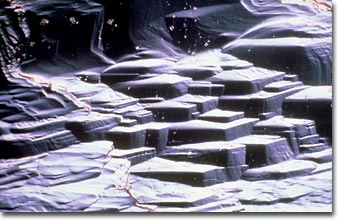Spike (M.I.) Walker
Amethystine Quartz Crystal
English photomicrographer Spike (M.I.) Walker has been a consistent winner of the Nikon Small World competition for many years and has published many articles and a book about microscopy. Featured below is a photomicrograph revealing a facet of an amethystine quartz crystal.

|
The surface of a facet of an amethystine quartz crystal. The objective was a 5.5x/0.15 NA achromatic objective with a Nomarski DIC prism and vertical illuminator (reflected light) utilizing crossed polarizers. Illumination was provided by a 12-volt, 100-watt tungsten-halide lamp. The camera system employed for photomicrography was a Reichert Zetopan with a Photoautomatic 35-millimeter camera. Film was Ektachrome 64. (16x) |
Amethyst is a form of silica mineral quartz that is valued as a semiprecious gem for its violet color and attractively shaped crystals. Most quartz samples are clear, but amethyst has a beautiful violet color, which many experts attribute to small amounts of iron impurities in the crystal lattice. Others, however, theorize that the color arises from the presence of manganese or hydrocarbons. Amethysts lose their color or become yellowed when heated. Citrine gemstones, which are actually somewhat rare in nature, are often created by heat treating low grade, inexpensive amethysts.
The name amethyst comes the Greek amethystos, "not intoxicated," which some speculate expresses the ancient folk belief that the stone protects its owner against drunkenness. More likely, the Greeks were probably referring to the wine-like color of some stones.
Amethysts are found in a wide variety of locations around the world. The finest specimens are found in India, Sri Lanka, and Brazil. The crystals also occur from the Ural Mountains of Russia and Europe to many parts of Scotland, and in areas of North America, such as Ontario and North Carolina.
